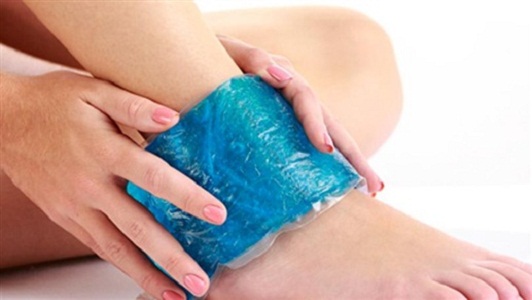Put the Ice Pack Down: Icing an Injury Doesn't Help It Heal

Conventional wisdom has it that if you hurt yourself, you should ice the injury. Like bringing a gift to a wedding, it's just what you do. Unfortunately, recent science calls that into question - so much so that the man who popularized icing as a practice now argues that it's harmful.
Ice is a pretty ancient substance - just ask Antarctica - but it was first pitched as a treatment for muscle injuries in 1978. That year, Dr. Gabe Mirkin released "The Sports Medicine Book," which laid out what's known as the RICE method: Rest, Ice, Compression, Elevation. ("Elevation" just requires lifting the injured area above your heart, not scaling a mountain.)
Dr. Mirkin's book was a prompt bestseller and the RICE method became the gold standard of care, especially for muscle injuries. Today, you can buy an ice pack in basically any store. Icing reigns online, too; Google "sprained ankle care" or "pulled muscle care" and the RICE method will be the first search result. Athletes are so into it, they've taken it beyond the ice pack. Pros like Usain Bolt and Lebron James take full-blown ice baths or even hop into cryogenic freezing chambers to recover from intense workouts.
The medical reasoning behind all this cooling? Well, it's all anti-inflammatory. Cold temperatures divert blood flow from injured muscles, sending it rushing back towards the vital organs, which minimizes swelling and supposedly speeds recovery. Ice also numbs the area around an injury and temporarily reduces pain, much like an anesthetic would.
At least, that's the pro-ice argument. But does research back this up?
- A Second Look at Ice
Not according to Dr. Mirkin. In a blog post, he basically retracted his endorsement of the "I" in his signature RICE method.
He argues that research has never fully backed the idea that ice accelerates healing. Perhaps it reduces swelling, but that's a cosmetic benefit, not a therapeutic one - and elevation, another component of the RICE method, reduces swelling, too. What's more, ice might hinder healing in the long-term. In one 2013 study, for instance, icing slowed recovery after an intensive sequence of elbow extensions.
Dr. Mirkin now argues that while swelling is unpleasant to look at, it's also inflammation, part of the human immune system's natural response to injury. "Anything that reduces your immune response will also delay muscle healing," Dr. Mirkin writes.
That includes ice. Dr. Mirkin now recommends a modified RICE method that just consists of rest, compression, and elevation. The REC method?
Other scientists take a less anti-ice stance. Sure, it's not a cure-all, but they argue it merits more rigorous study. Oddly, though we've all been icing our throbbing ankles for decades, research looking into the practice remains patchy. The 2013 study above, for instance, had a sample size of 11.
Part of the issue? It's hard to execute a blind study of icing. When you ice a patient's injury, they know that they're receiving a "treatment," which means they can experience the placebo effect. This is a well-documented phenomenon that leads people to feel better if they just believe their injury has been treated.
Which is all to say that it's still possible that under certain circumstances, ice has more health benefits than drawbacks. Still, the next time you want to reach for an ice pack, think twice. You could try a new acronym entirely: physiologist John Paul Cantazaro's METH, or movement, elevation, traction (with a giant rubber band, say), and heat.
Or, you could just wait it out. Your body is pretty good at taking care of itself.








